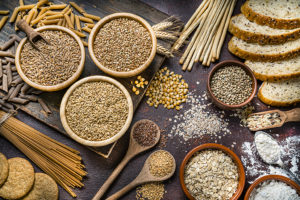
If you’ve been avoiding whole grains these days, you may want to reconsider.
That’s the advice from Kristi Artz, MD, medical director of lifestyle medicine at Spectrum Health.
“Research shows that people who eat more whole grains have a reduced risk of cardiovascular disease,” Dr. Artz said. “Whole grains are one of the main components of a plant-predominant diet.”
A diet rich in whole grains can reduce risk factors associated with cardiovascular disease, such as high blood pressure, high cholesterol and diabetes, she said.
Cardiovascular disease is a leading cause of death globally. In 2019, about 18 million people died from cardiovascular disease, the vast majority either from stroke or heart attack.
In the U.S., a person dies from cardiovascular disease every 36 seconds, according to the Centers for Disease Control and Prevention. It’s responsible for about 1 in 4 deaths.
Quitting smoking, losing excess weight and living an active lifestyle are among the best ways to avoid heart problems.
But a healthy diet is also essential—and whole grains are a big part of it.
Food as medicine
Whole grains may be as powerful as medications in lowering blood pressure, Dr. Artz said.
Three servings of whole grains each day may provide the same benefit as some medications when it comes to reducing systolic blood pressure in particular, she said. (Systolic measurement indicates the amount of pressure your blood is exerting against your artery walls when the heart beats.)
Whole grains are widely available at grocery stores and they’re generally affordable and easy to cook, Dr. Artz said. Typically, the best whole grains can be cooked on the stove.
You can mix them in a 1-to-1 ratio with water and then cook them for 20 minutes. Whole oats, brown rice, millet and quinoa can be eaten plain, with fruit, in soups or in endless other easy-to-make recipes.
Whole grains are an excellent source of fiber, which helps manage weight and regulates blood pressure, assisting in the all-important fight against cardiovascular disease.
But whole grains also play a role in combating diabetes.
Some studies suggest you can lower your risk of diabetes by replacing white rice with brown rice and switching to other whole grains.
Dangerous difference
As you set out to explore the exciting world of grains, arm yourself with knowledge.
Refined grains, for example, are dramatically different from whole grains and, unfortunately, the marketing on packages today can be misleading.
Refined grains have fiber and nutrients stripped away. This leaves just starch and calories, Dr. Artz said.
Most packaged foods have refined grains, which means many of the good qualities of whole grains have been removed through processing. Refined grains can also cause inflammation and weight gain.
It’s important to read a product’s nutrition label to make sure whole grains are listed as the first ingredient.
Focus on fiber content, too.
Dr. Artz recommends following the 5-1 rule—a healthy product should have no more than 5 grams of carbohydrates to 1 gram of fiber.
Whole grains are the foundation of a plant-predominant diet, but you should also make sure you’re eating a healthy variety of other plant foods, such as beans, fruits and vegetables.
Aim to get the majority of your calories from whole plant foods, she said.
She recommends limiting your consumption of animal products such as red meat, chicken, fish and dairy. Think of these items as condiments, not something you’d place in the center of your plate.
 /a>
/a>
 /a>
/a>
 /a>
/a>
I love whole grains. They are a big part of my diet. Thanks for sharing this article.
Great post, Lots of helpful tips! Thanks so much for sharing and thank you so much for hosting as well.
I totally agree with your blog! A diet rich in whole grains can reduce risk factors associated with cardiovascular diseases, such as high blood pressure, high cholesterol, and diabetes. But with a healthy diet, we can overcome these issues. Whole grain food is important to us. Without this, we have to face such kinds of issues. You say “Whole grains may be as powerful as medications” this is correct. And with this healthy diet, we have to do our regular checkups in the finest and advanced labs to know about abnormalities that take place in our body and get cured earlier before it becomes a big issue.
I am still confused as to what are “whole grains”, and how to incorporate them into meals. Most packaging does not make it clear, or use buzz words to describe their contents. I kept waiting for this article to use good examples of what whole grains are. Perhaps the reason people don’t eat enough is not enough information?